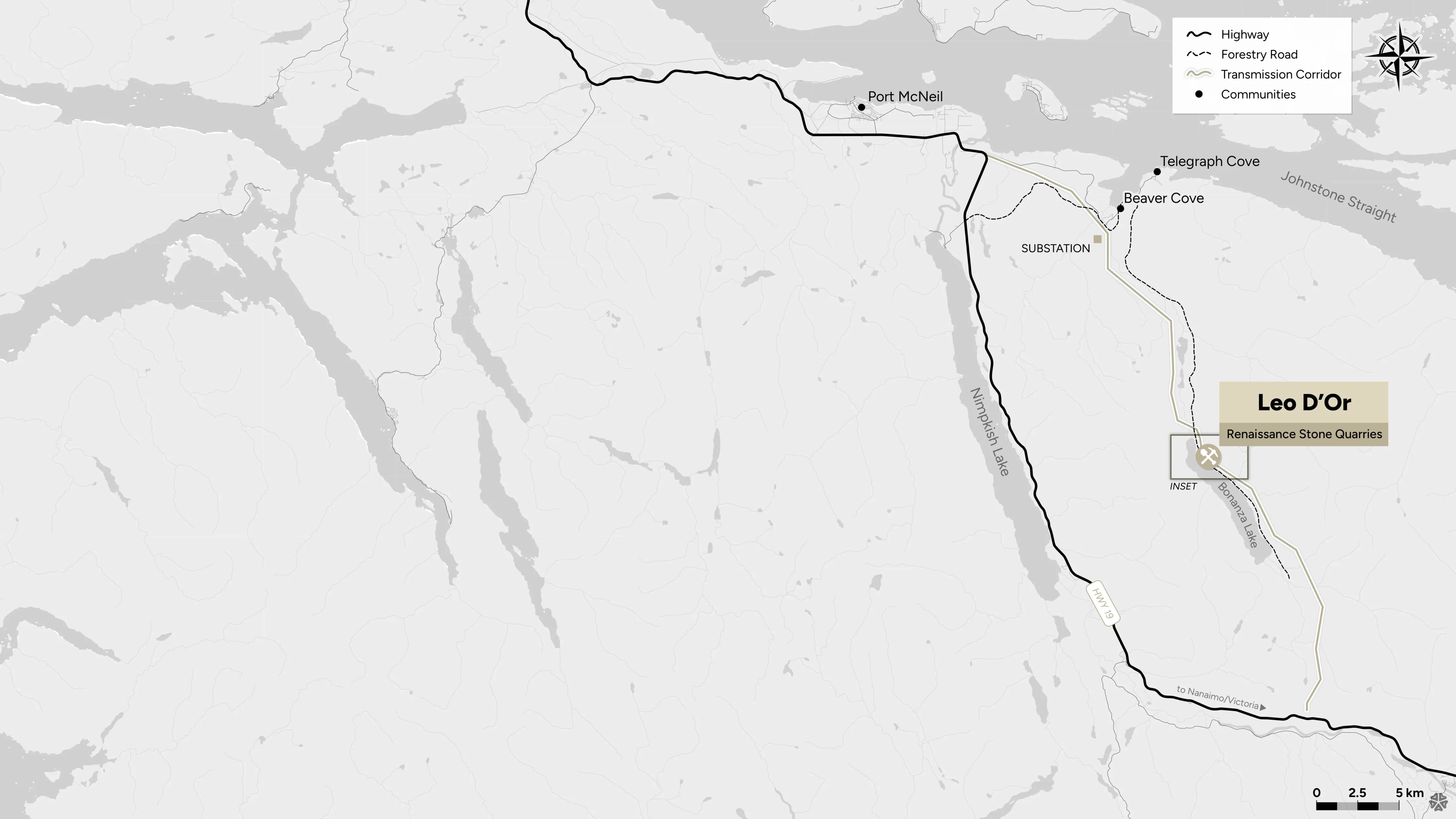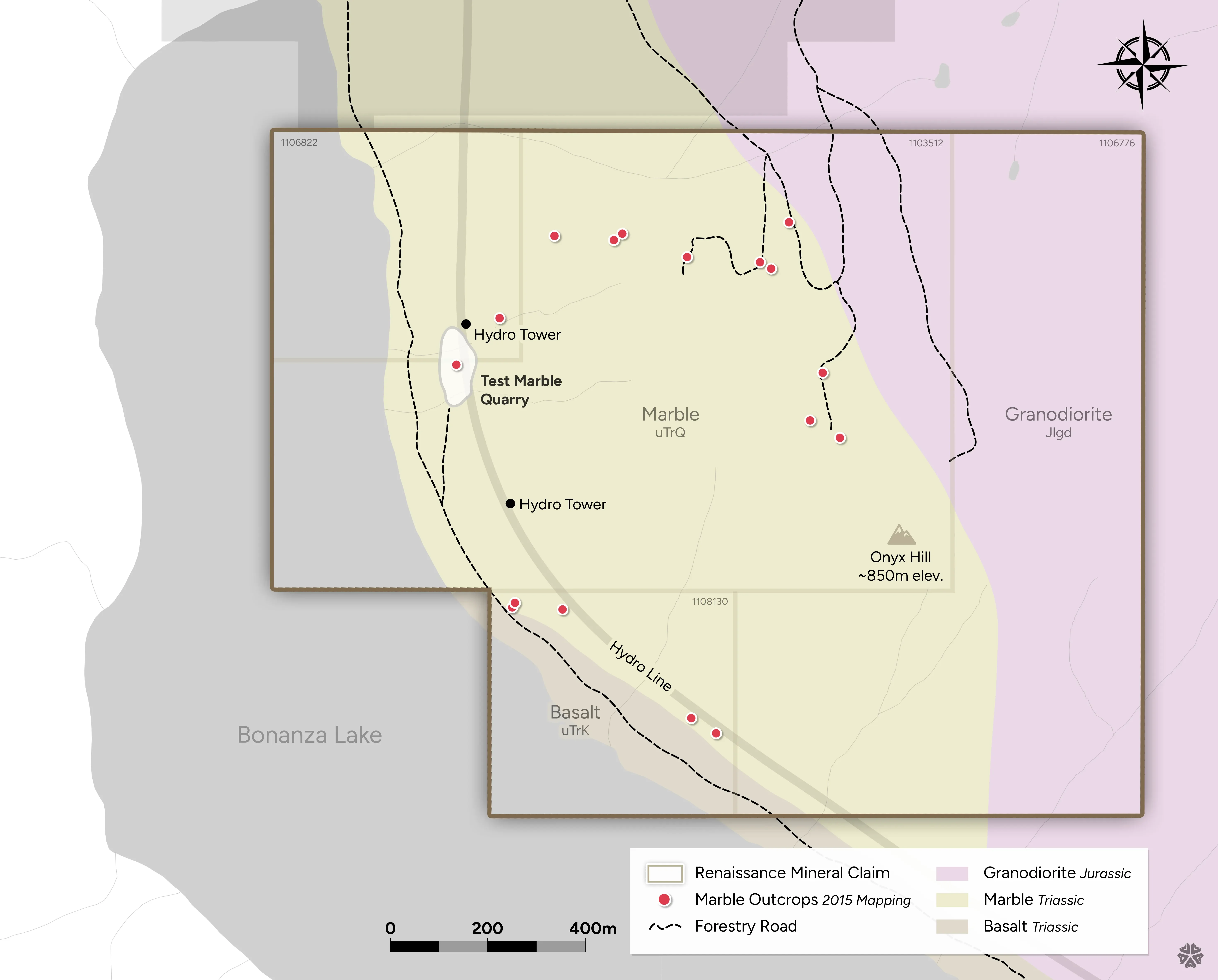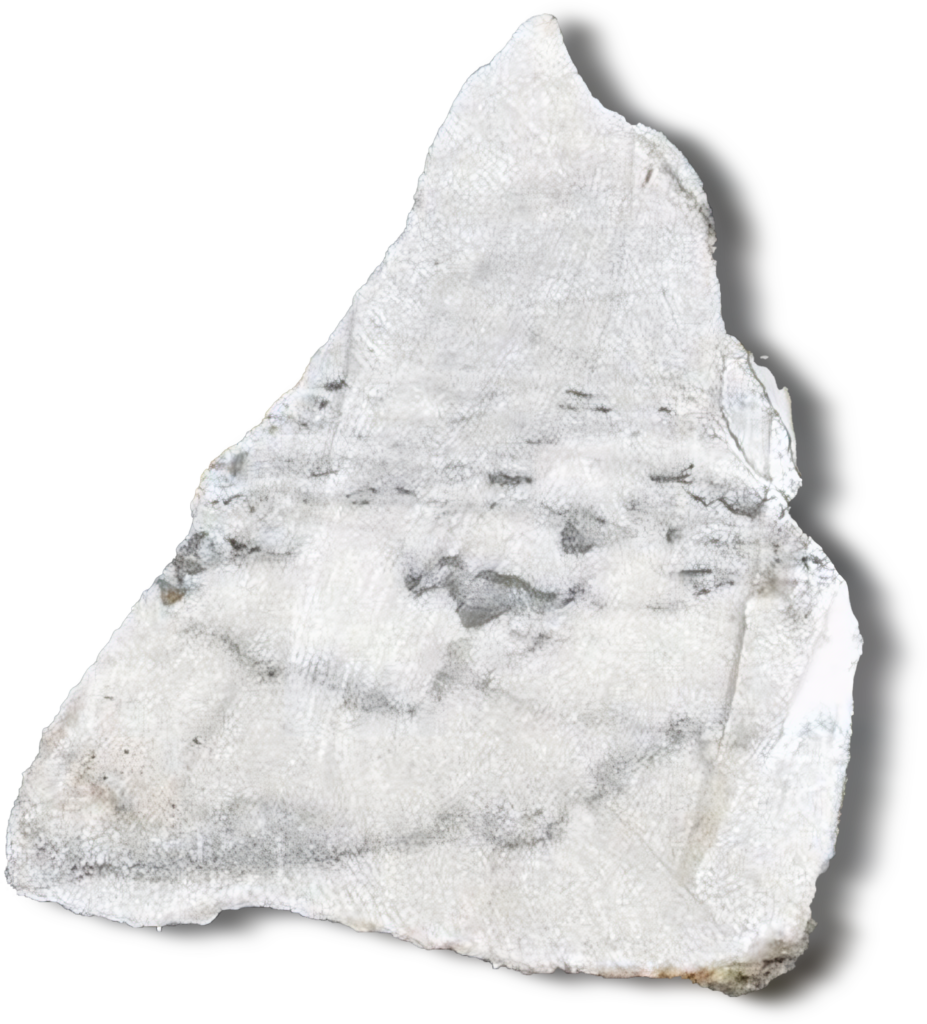Renaissance Stone Quarries
Leo D'Or
Property

Property Location
Prime Location
The property is located on North Vancouver Island, 50km southeast of Port McNeill, the closest town.
Accessible Airports
Port McNeill has a small airport and there is a larger airport at Port Hardy, 50km up the coast to the west. The region has a major road network and there are well maintained forestry roads to the property.
Convenient Transportation
The property is a 45-minute drive from Port McNeil and a 4 hour drive north from Nanaimo (via a short air, seaplane, BC ferries and Hullo passenger ferry from Vancouver)

Property Infrastructure
The surrounding area includes infrastructure: a 20-kilometer forestry road, with no weight restrictions, direct to property gate beginning Beaver Cove; forestry road connects to Vancouver Island’s British Columbia Highway #19; a logging tidewater port; BC Hydro transmission power lines traverse the property with a nearby substation; water accessible from Bonanza Lake; located just 50-kilometers southeast of Port McNeill, the nearest town; and the property can be reached with a six-hour drive from Vancouver, including the short ferry ride.
Project History & Geology
A thick band of Triassic Quatsino Formation limestone on the Leo D’Or property has been recrystallized to marble by the events associated with the intrusion of a younger Jurassic age granite. The marble shows uniformity of colour with historical testing showing high compressive strength and colour uniformity
1988 - 1989
A Bianca Carrara style marble deposit was discovered on the property. Klohn Leonoff (Eng. Consultants) subsequently identified an area of 250 x 300 metres of marble, equivalent to 648,000 tonnes with 324,000 tonnes recoverable as large blocks
1993
An area of 600 x 300mwas identified as being consistent in colour and an additional two areas were identified as areas with potentially good marble
1990's & 2018-2020
Marble quarry in operation with undocumented quantities of marble extracted.
DISCLAIMER: This preliminary historical estimate was done by Klohn Leonoff Consulting Engineers of Vancouver, BC and presented in Report 830888, Leo d’Or Mining Inc. Leo D’Or Marble Deposit Project; A report of the feasibility of mining and manufacturing; Appendix 7a by Klohn Leonoff Report (Summary of Field Work and Preliminary Evaluation – Bonanza Lake Marble Property, April 8 1988). Assumptions: the marble at depth is similar to at surface; average slope is 30deg, rock waste 50%, quarry slopes will extend up at ~60 deg and a unit weight is 2752 kg/cubic metre. This historical data is summarized in the 2023 Technical Report (pending review). The author and qualified person of the Technical Report has not done sufficient work to classify the historical estimate as current mineral resources or mineral reserves. Updated estimates are not available. It is important to note that significant marble extraction has occurred since the historical resource
Leo D’Or Marble Quarry
Traditionally, marble is extracted as blocks weighing up to 25 tonnes (25 tonnes = blocks approximately 2.75m x 1.6m x 2.1m) and can be custom cut to client specifications. Marble is used to make countertops, floor and wall tiles, and display art. Marble also presents opportunities for waste utilization in various forms such as aggregate, flux, small tiles, coasters, terrazzo, cement fillers, landscape stone, and fertilizer.
Chemical Analysis *
| % | M | O |
|---|---|---|
| CaO | 54.72 | 55.60 |
| Al₂O₃ | 0.02 | (0.01) |
| BaO | (0.01) | (0.01) |
| Fe₂O₃ | 0.21 | 0.09 |
| K₂O | (0.01) | (0.01) |
| MgO | 0.38 | 0.33 |
| MnO | (0.01) | (0.01) |
| Na₂O | 0.08 | 0.09 |
| P₂O₅ | 0.07 | 0.07 |
| SiO₂ | 0.50 | (0.01) |
| TiO₂ | 0.01 | (0.01) |
| LOI | 42.94 | 43.31 |
Physical and Chemical Analysis
Physical and chemical testing prior to opening of the quarry in the ‘90’s indicates minimal impurities and competent marble suitable for use as dimension stone.
Physical Analysis **
| LDO1 | LDO2 | |
|---|---|---|
| Modulus of Rupture (MPA) | 7.45 | 7.52 |
| Bulk Specific Gravity | 2.71 | 2.70 |
| Absorption | 0.10 | 0.11 |
| Compressive Strength | 15,800 psi | 14.900 psi |
| Grain size varies from fine to coarse-grained with 75% medium grained | ||
* 2 Samples collected in 1991 by Harvard Cap Corp. and analysed by Chemex Labs. Results comparable to earlier analyses by government. Exact locations of these samples is unknown.
** 2 samples collected by BC Ministry of Energy, Mines & Petroleum and analysed by Lab of Ministry of Transportation & Highways, year unknown but prior to 1991. Strength tests exceeded ASTM standards. Exact locations of these samples is unknown.







